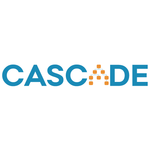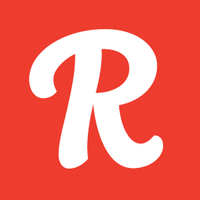Best Goal Management Software
Best goal management software includes weekdone, clickup, trakstar, stack by, and databox. This allows for continuous progress tracking. Best goal management software can help employees keep tabs on their achievements and set new objectives on a frequent schedule.



No Cost Personal Advisor
List of 20 Best Goal Management Software
Category Champions | 2024
Complete employee experience platform
Keka is the best HR software for businesses of all sizes. It is the only Payroll & HRMS software that is employee-centric. Unlike traditional HRMS solutions, it is a modern new generation platform focused on user experience and simplifying complex workflows. Read Keka Reviews
Explore various Keka features, compare the pricing plans, and unlock the potential of seamless operations by selecting the right software for your business.
Features
View all Keka Features- Application Management
- Candidate Management
- Pay Slip
- Email Integration
- Job Comparison
- Multi Company
- Data Security
- MIS Reports
Pricing
Foundation
$ 97
Upto 100 Employees
Strength
$ 194
Upto 100 Employees
Keka Caters to
- StartUps
- SMBs
- Agencies
- Enterprises
Category Champions | 2024
factoHR - HR Solution for Growth
factoHR is an award-winning Best HR Platform trusted by 3500 Companies & 2.6 million employees, which includes Tata Steel BSL, DENSO, Cycle Agarbatti, BSE, Murugappa, & many others who have improved their productivity by more than 70 % Read factoHR Reviews
Explore various factoHR features, compare the pricing plans, and unlock the potential of seamless operations by selecting the right software for your business.
Features
View all factoHR Features- Chatbot
- Normalization
- Self-onboarding
- Review Cycle Tracking
- Asset Management
- Bonus
- Project Tracking
- Time Off Management
factoHR Caters to
- StartUps
- SMBs
- Agencies
- Enterprises
Emergents | 2024
Software by Saba Software
Performance@Work is give your people the right tools to understand your business plan, their role in the company’s success. Manage progress towards goals on the go, from any mobile device or tablet. Learn more about Performance@Work
Explore various Performance@Work features, compare the pricing plans, and unlock the potential of seamless operations by selecting the right software for your business.
Performance@Work Caters to
- StartUps
- SMBs
- Agencies
- Enterprises
Emergents | 2024
Software by Cascade Strategy
Starting from planning to execution, Cascade Strategy maintains quality in your strategies. The strategic management software offers a whole range of KPI and project management and on-report tracking tools to eliminate hassles and errors. Learn more about Cascade Strategy
Explore various Cascade Strategy features, compare the pricing plans, and unlock the potential of seamless operations by selecting the right software for your business.
Features
View all Cascade Strategy Features- Budget Management
- Project Management
- Idea Management
- Scenario Planning
- Collaboration Tools
- Time Tracking
- Percent-Complete Tracking
- Dashboard
Cascade Strategy Caters to
- StartUps
- SMBs
- Agencies
- Enterprises
Emergents | 2024
See the Big Picture, Focus to Get Things Done
Goalscape is a unique Visual Management solution for ambitious teams, companies and individuals. The Goalscape Web App provides full sharing for collaboration with purpose. Learn more about Goalscape
Explore various Goalscape features, compare the pricing plans, and unlock the potential of seamless operations by selecting the right software for your business.
Features
View all Goalscape Features- Review Cycle Tracking
- Team Management
- Collaboration
- Workflow Configuration
- HR Management
- Access control
- Sprint Planning
- Supports Scrum
Pricing
Goalscape Yearly
$ 99
Per Year
Goalscape Caters to
- StartUps
- SMBs
- Agencies
- Enterprises
Category Champions | 2024
A Cloud based Performance Management Software
Synergita is a cloud-based, continuous employee performance management software. It automates employee talent data, employee goals alignment, continuous employee performance reviews & feedback, employee engagement, employee development & retention. It is extremely simple and easy to use. Read Synergita Reviews
Explore various Synergita features, compare the pricing plans, and unlock the potential of seamless operations by selecting the right software for your business.
Features
View all Synergita Features- 360 Degree Feedback
- Goal Setting / Tracking
- CRM & Sales Dashboards
- Employee Profile
- Applicant tracking
- Compensation Management
- Key Performance Indicators
- Feedback Management
Pricing
Synergita Engage
$ 0
User/Month
Synergita Perform
$ 1
User/Month
Synergita Perform Plus
$ 1
User/Month
Synergita Caters to
- StartUps
- SMBs
- Agencies
- Enterprises
Category Champions | 2024
Manage and engage your workforce wherever they are
Sage HR is fast-becoming 1 HRIS software in staff leave and employee database management. By reducing the overhead time and money spent on paper chasing employees' leave requests, Sage HR helps you to solve your HR challenges and let’s you to focus on building your business! Read Sage HR Reviews
Explore various Sage HR features, compare the pricing plans, and unlock the potential of seamless operations by selecting the right software for your business.
Features
View all Sage HR Features- Employee Profile
- Applications Management
- Survey Builder
- Online resignation
- Employee Directory
- Attendance management
- Payroll Management
- Drag & Drop
Pricing
Leave Management
$ 5
Per Employee
Performance Management
$ 3
Per Employee
Shift Scheduling
$ 3
Per Employee
Sage HR Caters to
- StartUps
- SMBs
- Agencies
- Enterprises
Contenders | 2024
Award-Winning Employee Performance Management Soft
CRG emPerform provides easy-to-use, affordable, and effective employee performance management software to help organizations eliminate manual processes and grow a long-term, ongoing performance management process to align, develop, reward, and retail top talent. Read CRG emPerform Reviews
Explore various CRG emPerform features, compare the pricing plans, and unlock the potential of seamless operations by selecting the right software for your business.
Features
View all CRG emPerform Features- Ad Hoc Reports
- Feedback Management
- Surveys & Feedback
- Compensation Management
- Individual Development Plans
- Custom Rating Scales
- Peer Appraisals
- Custom Review Forms
Pricing
Subscription License Plan (les than)
$ 3
User/Month
CRG emPerform Caters to
- StartUps
- SMBs
- Agencies
- Enterprises
Emergents | 2024
Software by Stackby
Stackby is a fully featured Project Management Software designed to serve Agencies, Enterprises. Stackby provides end-to-end solutions. This online Project Management System offers to Collaborate, Customize Data, Integrate at one place. Learn more about Stackby
Explore various Stackby features, compare the pricing plans, and unlock the potential of seamless operations by selecting the right software for your business.
Features
View all Stackby Features- Application Integration
- Collaboration
- Spreadsheet View
- Goal Management
- Project Management
Pricing
Personal
$ 5
Per Month
Economy
$ 9
Per Month
Business
$ 18
Per Month
Stackby Caters to
- StartUps
- SMBs
- Agencies
- Enterprises
Emergents | 2024
Software by Runrun.it
Runrun.it is a fully featured Project Management Software designed to serve Agencies, Enterprises. Runrun.it provides end-to-end solutions. This online Project Management System offers to Collaborate, Customize Data, Integrate at one place. Learn more about Runrun.it
Explore various Runrun.it features, compare the pricing plans, and unlock the potential of seamless operations by selecting the right software for your business.
Features
View all Runrun.it Features- Goal Management
- Workflow Management
- Task Management
- Reporting
Pricing
Free
$ 0
User/Month
Business
$ 10
User/Month
Enterprise
$ 49
User/Month
Runrun.it Caters to
- StartUps
- SMBs
- Agencies
- Enterprises
Contenders | 2024
Software by Meridian 86 Pty Ltd
Lifetick is a fully featured Goal Management Software designed to serve Agencies, Enterprises. Lifetick provides end-to-end solutions. This online Goal Management System offers Task Email Reminders, Recurring Tasks, Goal and Task Reports at one place. Read Lifetick Reviews
Explore various Lifetick features, compare the pricing plans, and unlock the potential of seamless operations by selecting the right software for your business.
Pricing
Individual Free
$ 0
Per Month
Individual Paid
$ 5
Per Month
Teams
$ 10
Per Month
Lifetick Caters to
- StartUps
- SMBs
- Agencies
- Enterprises
Contenders | 2024
Effective OKRs for real company results, since 201
OKR best practices combined with a simple and modern interface for best results and ease-of-use. Set quarterly goals for your company and teams. Track progress in real time and provide feedback. Effective OKRs for real company results. Read Weekdone Reviews
Explore various Weekdone features, compare the pricing plans, and unlock the potential of seamless operations by selecting the right software for your business.
Features
View all Weekdone Features- Question Library
- Social Recognition
- Benchmarking
- Goals & KPI’s
- Goal Management
- Ad Hoc Reports
- Feedback Management
- Prioritization
Pricing
OKRs + Weekly Planning
$ 108
4-10 User Package, monthly Payment
OKRs + Weekly Planning
$ 0
1-3 user package
OKRs + Weekly Planning
$ 162
11-15 User Package, Monthly Payment
Weekdone Caters to
- StartUps
- SMBs
- Agencies
- Enterprises
Emergents | 2024
An eSignature app to streamline your paperwork
A highly secure tool for signing and sharing documents online, instead of a print-sign-scan-send routine. The app is available for $6.66 per user per month, with a 14-day free trial. Learn more about KeepSolid Sign
Explore various KeepSolid Sign features, compare the pricing plans, and unlock the potential of seamless operations by selecting the right software for your business.
Features
View all KeepSolid Sign Features- Notes Management
- Multi-Party Signing
- Mobile Signature
- Collaboration
- Templates
- Document Overview
- File Sharing
- Progress Tracking
Pricing
Personal
$ 10
User/Month
Small Team (5 users)
$ 40
Team/Month
Big Team (10 users)
$ 72
Team/Month
KeepSolid Sign Caters to
- StartUps
- SMBs
- Agencies
- Enterprises
Contenders | 2024
Software by Airtable
Airtable is the solution for CRM to manage all-in-one with powerful features. It suits for such business like entertained, restaurant and hotels. It is very accurate and flexible software that delete all the duplication itself and integration with social media for secure communication. Read Airtable Reviews
Explore various Airtable features, compare the pricing plans, and unlock the potential of seamless operations by selecting the right software for your business.
Features
View all Airtable Features- CRM & Sales Dashboards
- Sales Dashboards & Reports
- Lead Management
- Access Monitoring
- Workflow Management
- List Management
- Product Database
- Project Management
Pricing
Free
$ 0
User/Month
Plus
$ 10
User/Month
Pro
$ 20
User/Month
Airtable Caters to
- StartUps
- SMBs
- Agencies
- Enterprises
Contenders | 2024
Performance Review, Appraisal & Continuous Feedbac
An OKR driven agile Performance Management Software for Performance Reviews, Appraisals and Continuous Feedback. Align employee goals and performance to organizational objectives: OKR Goals, 360 Feedback, Chat based Interface, Competency driven. Read PossibleWorks Reviews
Explore various PossibleWorks features, compare the pricing plans, and unlock the potential of seamless operations by selecting the right software for your business.
Features
View all PossibleWorks Features- Goals
- Competency Scale
- On-going Performance Tracking
- Employee Awards
- Peer-to-Peer Recognition
- Rewards Points
- Feedback Management
- AI / Machine Learning
Pricing
Engage Plan
$ 0
Per User/Month
Performance Plan
$ 1
Per User/Month
PossibleWorks Caters to
- StartUps
- SMBs
- Agencies
- Enterprises
Emergents | 2024
Online HR management software for SMBs
SutiHR is a robust online HR software solution that provides powerful tools for every part of the HR cycle from recruitment to separation. Advanced analytics and dashboards that are easy to use simplify decision-making at different stages of the HR process. Learn more about SutiHR
Explore various SutiHR features, compare the pricing plans, and unlock the potential of seamless operations by selecting the right software for your business.
Features
View all SutiHR Features- Performance Management
- MIS Reports
- Project Management
- Loan & Advances Management
- Recruitment Management
- Bonus
- Training Management
- Employee Self Service Management
Pricing
Basic
$ 4
User/Month
SutiHR Caters to
- StartUps
- SMBs
- Agencies
- Enterprises
Category Champions | 2024
Free Project Management Tool
Asana a project management system centers your team's communication on the work you're doing, keeping everyone on the same page. It is flexible enough for your team’s unique work and communication. Read Asana Reviews
Explore various Asana features, compare the pricing plans, and unlock the potential of seamless operations by selecting the right software for your business.
Features
View all Asana Features- Agile Methodologies
- Data Imports/Exports
- Project Templates
- Project Planning
- Time Tracking
- Prioritization
- Portfolio Management
- Time & Expense Tracking
Pricing
Free
$ 0
User/Month
Premium
$ 8
User/Month
Asana Caters to
- StartUps
- SMBs
- Agencies
- Enterprises
Emergents | 2024
Software by TeamGantt
TeamGantt is a project management system for natural and nice project planning and team communication. It provides functionalities i.e allow multiple projects, simple for staff members, attractive presentation, upload file, conversations and connections with time tracking system. Read TeamGantt Reviews
Explore various TeamGantt features, compare the pricing plans, and unlock the potential of seamless operations by selecting the right software for your business.
Features
View all TeamGantt Features- File Sharing
- Employee Scheduling
- Project Management
- Gantt Charts
- Project Templates
- Time Tracking
- Budget Management
- Portfolio Management
Pricing
Free
$ 0
Per Month
Standard
$ 25
User/Month
Advanced
$ 30
User/Month
TeamGantt Caters to
- StartUps
- SMBs
- Agencies
- Enterprises
Emergents | 2024
Simple employee evaluation software anyone can use
Trakstar is a web-based Human Resources software. Very helpful to build a productive organizational culture. Includes powerful functionality like Appraisal management, Reporting, Performance Ranking, Goal management etc. Learn more about Trakstar Perform
Explore various Trakstar Perform features, compare the pricing plans, and unlock the potential of seamless operations by selecting the right software for your business.
Features
View all Trakstar Perform Features- Applications Management
- Self-Appraisals
- Goal Setting / Tracking
- Peer Appraisals
- Self Service Portal
- Cascading Goals
- 360 Degree Feedback
- Applicant tracking
Trakstar Perform Caters to
- StartUps
- SMBs
- Agencies
- Enterprises
Contenders | 2024
Global HR Software to Automate Your Processes
ClayHR is an AI-enabled cloud-based HR software for global organizations. It offers centralized employee records, employee onboarding/offboarding, time & attendance management, asset management, with a presence in over 160 countries. Read ClayHR Reviews
Explore various ClayHR features, compare the pricing plans, and unlock the potential of seamless operations by selecting the right software for your business.
Features
View all ClayHR Features- Progress Tracking
- Employee Portal
- Asset Management
- Evaluation Management
- Workforce Management
- Background Screening
- 360 Degree Feedback
- Succession Planning
Pricing
Start From
$ 0
Employee/Month
ClayHR Caters to
- StartUps
- SMBs
- Agencies
- Enterprises
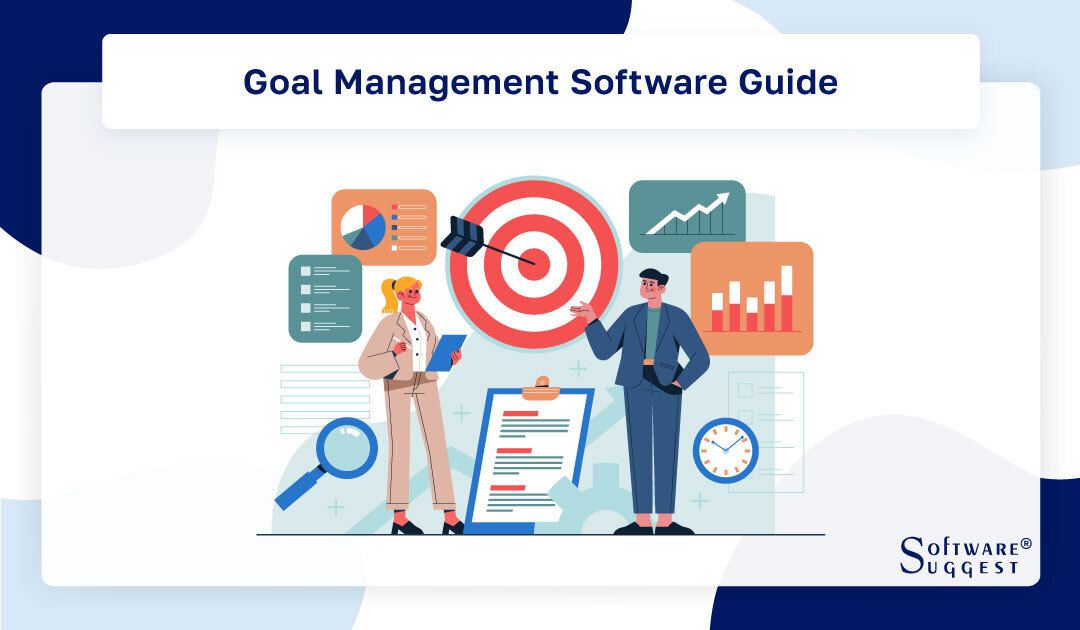
In the workplace, goals are essential for success. They provide guidance during challenging times, helping individuals stay focused on critical issues. Employers benefit from goals by keeping their workforce on track and aligning individual objectives with organizational aims.
This is where goal management software comes in handy. Utilizing goal-setting software further enhances this process, catering to the specific needs of businesses.
What is Goal Management?
Goal management is a structured framework of administrative tasks aimed at formulating and achieving the organization's objectives, both at the organizational and individual levels.
Goal management is not an additional managerial function that merely reacts to events; rather, it is a proactive approach that aligns efforts toward the overarching objective of the organization. In practical terms, every staff member, without exception, is directly or indirectly associated with the organization's objectives.
What is Goal Management Software?
Goal-setting software is a tool that helps individuals or organizations define specific, measurable, achievable, relevant, and time-bound objectives. It assists in planning, managing, and tracking goals, providing clear direction. This software also aids employees in learning and improving over time, enhancing employee engagement and enabling regular check-ins on goal progress.
Who are the Users of the Goal Management Software?
Understanding the key users of goal-setting software helps organizations to implement it effectively within an organization. Here are some key users for this software.

-
Managers and Team Leaders
Managers and team leaders rely on goal-setting software to set clear objectives for their teams, allocate resources efficiently, and monitor progress in real-time. GMS provides a centralized platform to communicate goals, track performance, and provide constructive feedback to team members. This streamlined approach promotes accountability and ensures everyone is aligned toward a common objective.
-
HR Professionals
Human resources professionals play a pivotal role in talent management and development within an organization. They use goal-setting software to make sure that each employee's goals are in line with the company's overall strategic goals. As a result, every employee will be ensured to be making progress toward the overarching organizational goal. In addition, GMS gives HR managers helpful information about employee performance and productivity.
-
Sales Teams
For sales teams, goal-setting software sets and monitor sales targets, track leads, and measure conversion rates. It provides a comprehensive view of the sales pipeline, enabling teams to identify areas for improvement and make data-driven decisions. GMS ultimately leads to increased sales efficiency and effectiveness.
-
Performance Management Specialists
With GMS, performance management specialists can customize performance metrics and set clear employee expectations. It provides a centralized platform to track progress and identify areas for development. Additionally, GMS facilitates the creation of personalized development plans, allowing specialists to offer targeted support and coaching.
In the long run, it results in more accurate employee output and greater job satisfaction.
-
Consultants and Coaches
For consultants and coaches, GMS provides a structured framework to collaborate with clients in defining clear and actionable goals. It facilitates ongoing progress tracking and performance analysis, allowing them to provide data-driven recommendations.
Moreover, consultants and coaches can showcase the tangible impact of their services, building credibility and trust with their clients.
What are the Benefits of Using Goal Management Software?
Using goal-setting software offers a range of benefits that are integral to achieving organizational success. Here are six significant benefits of utilizing such software.
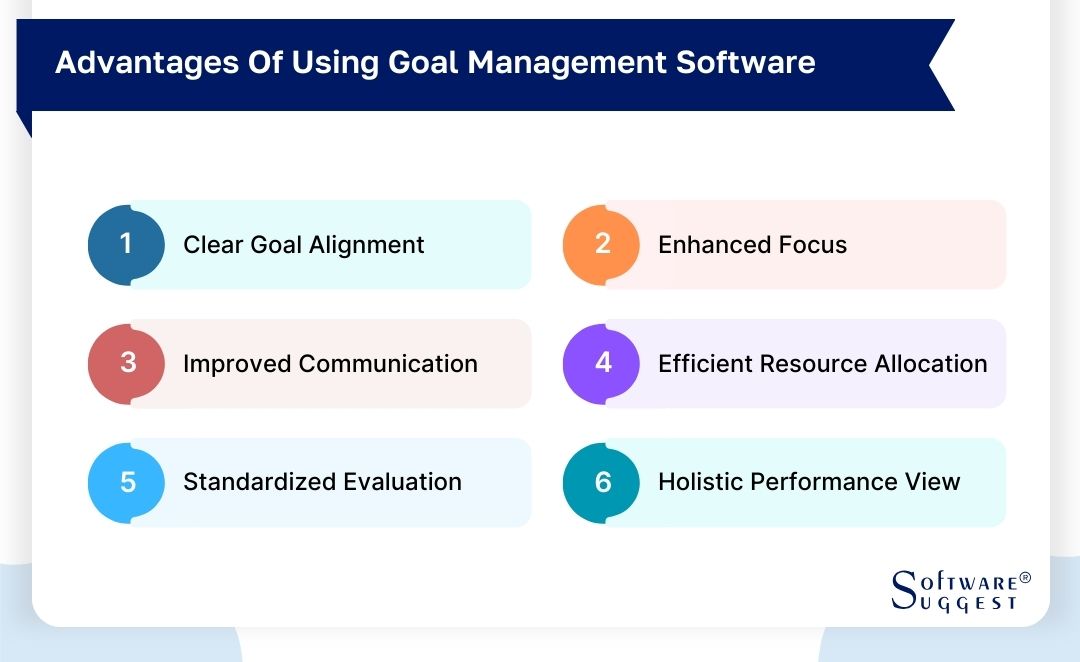
-
Clear Goal Alignment
One of the primary advantages of using goal-setting software is the ability to align individual and team objectives with the broader organizational goals. The software promotes transparency and guarantees that each team member is aware of their specific responsibility for achieving the organization's overall goal. This sense of unity and group effort toward common goals is encouraged by this clarity of purpose.
-
Enhanced Focus
Goal-setting software provides a structured framework for setting and tracking goals, allowing teams to prioritize tasks effectively. By dividing greater objectives into more doable tasks, staff members can stay concentrated on their duties. This prevents the dispersion of efforts on less critical tasks and ensures that resources are directed toward achieving the most important objectives.
-
Improved Communication
The best goal-tracking software acts as a centralized hub for sharing goals, progress updates, and feedback. This encourages open and honest communication within the company. A culture of teamwork and accountability is encouraged by the comfort with which team members can communicate, ask questions, and provide updates.
Clear communication also minimizes misunderstandings and ensures everyone is aligned with the overall goals.
-
Efficient Resource Allocation
Effective resource allocation maximizes productivity and minimizes waste. Businesses can strategically allocate resources like time, money, and labor by using goal management software. By identifying the most critical tasks and allocating resources accordingly, organizations can achieve better outcomes with optimized resource utilization.
-
Standardized Evaluation
Goal-tracking software provides objective metrics and real-time data for evaluating progress toward goals. This standardized approach to performance evaluation eliminates subjectivity and bias, ensuring that assessments are fair and consistent. Managers can track individual and team performance over time, identifying areas for improvement and recognizing achievements.
-
Holistic Performance View
Goal management software offers a comprehensive and in-depth analysis of various facets of performance within an organization. It goes beyond surface-level metrics and provides a nuanced understanding of how different elements contribute to overall progress and success.
This benefit allows stakeholders to gain insights into individual performance and how each team member's contributions align with the larger organizational goals.
What are the Features of the Best Goal Setting Software?
The best goal setting software boasts a range of features that separates it from other software available. Here are some features of the best goal setting software:
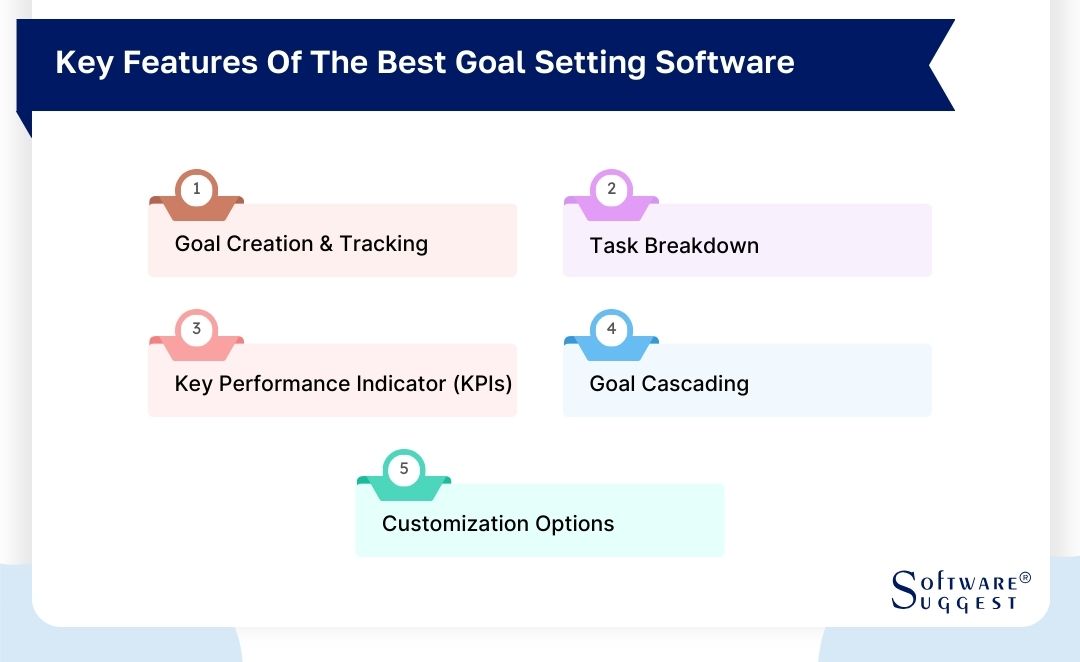
-
Goal Creation and Tracking
Goal-setting software provides a user-friendly interface for creating and tracking goals. Users can set SMART (specific, measurable, achievable, relevant, and time-bound) goals with its help. Additionally, it enables regular updates on progress, ensuring that goals stay on target and adjustments can be made as needed. Accountability and transparency within the company are encouraged by this feature.
-
Task Breakdown
A key to achieving goals is to divide larger objectives into smaller, easier-to-accomplish tasks. Goal-setting software facilitates this process by allowing users to create task lists associated with each goal. This guarantees that all members of the team are aware of the specific actions needed to accomplish the main goal. With task breakdown, employees can focus their efforts on actionable steps.
-
Key Performance Indicators (KPIs)
Goal-setting software incorporates key performance indicators (KPIs) to provide measurable metrics for evaluating success. These KPIs are benchmarks to assess whether goals are on track or adjustments are needed. By tracking KPIs, organizations can make data-driven decisions and ensure that goals align with strategic objectives.
-
Goal Cascading
In larger organizations with multiple tiers of management, goal cascading is a crucial feature. Goal-setting software makes it possible to match more general organizational objectives with the goals of individuals and teams. This guarantees that all organizational levels are working towards the same ultimate goals. Goal cascading fosters unity and cohesion in pursuing the company's mission and vision.
-
Customization Options
The goal-setting platform allows users to personalize their experience to align precisely with their unique needs and preferences. This feature empowers users to adapt the goal tracking software to their distinct processes and workflows, seamlessly integrating it into their existing operations. Moreover, users can define custom fields and attributes to capture specific information related to their goals.
How to Select the Right Goal Management Software?
For any organization, selecting the right and the best goal-setting software is important. The following will direct you through the important factors to make sure you make an informed decision.

-
Know your requirements
The first step in selecting the right goal-tracking software is understanding your organization's specific needs. Take into consideration your team's size, the challenges of your objectives, and any special needs. Are you focused on individual performance tracking, team collaboration, or both? It will be easier to reduce your options if you are clear about what you need.
-
Features and Usability
Evaluate the features offered by goal management software and assess how they align with your requirements. Look for essential functionalities like goal creation and tracking, task breakdown, KPI monitoring, goal cascading, and customization options.
Take into account the software's overall usability and user interface as well. It should be intuitive and user-friendly to encourage widespread adoption among your team members.
-
Integration Capabilities
Make sure your current tech stack can be seamlessly integrated with the goal-tracking software. This may include project management tools, CRM systems, and other crucial tools for your operations. Compatibility with your current systems will streamline workflows and enhance overall efficiency.
-
ROI and Value Proposition
Evaluating the Return on Investment (ROI) of a GMS is essential to justify the expenditure. Consider the value proposition offered by the software in terms of increased productivity, improved goal attainment, and overall organizational performance.
Moreover, review case studies and customer testimonials to gauge the success stories of organizations that have implemented the goal-tracking software.
-
Cost and Licensing
Budgetary considerations are of utmost importance when selecting any software solution. Consider the various goal-tracking software providers' pricing structures and available licenses. Consider whether they offer flexible plans that cater to the size and needs of your organization. Make sure to take into consideration any potential extra costs like implementation or training fees.
What are the Disadvantages of Goal Management Software?
Like any other tool, Goal Management Software comes with its own set of disadvantages that businesses should be aware of. Here are common disadvantages of such software:
-
Alignment with Organizational Goals
While goal management software is designed to align individual and team goals with the broader organizational objectives, there can be challenges in achieving perfect alignment. In some cases, there may be a disconnect between the software's capabilities and the specific goals or strategies of the organization. This misalignment can lead to inefficiencies and hinder the software's effectiveness.
-
Data Tracking and Quality
Accurate and reliable information is essential for goal-management success. However, there may be instances where data tracking within the software is not as precise or comprehensive as desired. This can result in incomplete or inaccurate goal progress updates, which in turn can lead to misguided decision-making. Ensuring the quality and accuracy of the data inputted into the software is crucial.
-
Cultural and Behavioral Challenges
Introducing goal management software may face resistance or challenges related to the existing company culture and employee behavior. Some team members may be accustomed to different methods of goal setting and tracking, and adapting to the new software may require a significant adjustment period.
-
Continuous Improvement
Goal management software, like any technology, may require ongoing adjustments and updates to meet evolving organizational needs. Keeping the software aligned with changing business strategies and goals is essential for its long-term effectiveness. Organizations must have a structured process in place for evaluating the software's performance and identifying areas where enhancements or modifications are necessary.
Market Trends in Goal Management Software Systems
Integrating goal management software systems revolutionizes the way businesses set, track, and achieve their objectives. And with continuous advancements in technology, there are numerous market trends shaping goal-setting platforms.
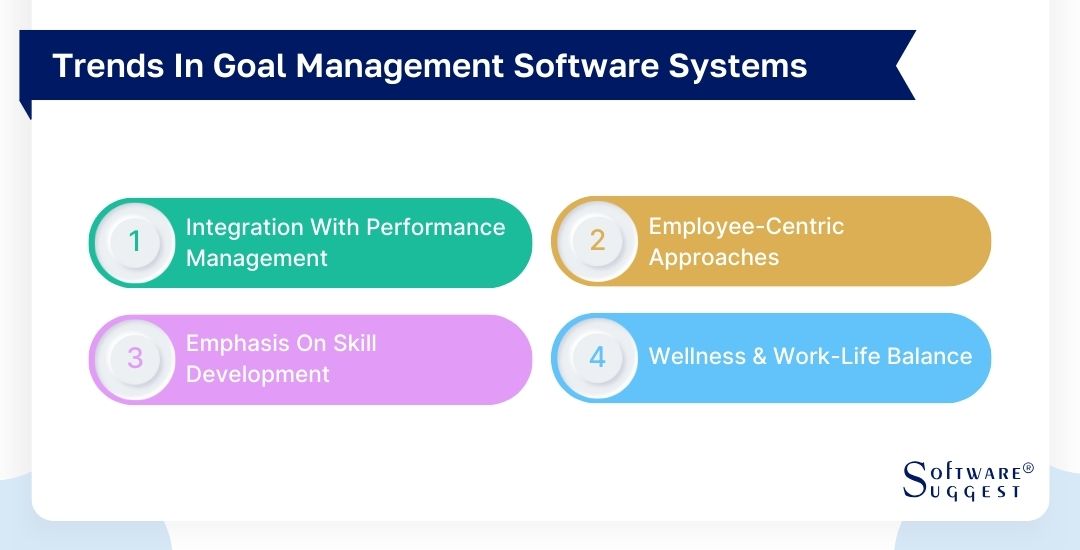
-
Integration with Performance Management
A significant trend in the goal management software market is the integration with performance management systems. Businesses are recognizing the value of aligning individual and team goals with overall performance evaluations. A more comprehensive understanding of a worker's achievements and contributions is made possible by this integration, resulting in accurate assessments and focused development strategies.
-
Employee-Centric Approaches
Modern goal management software systems are placing a greater emphasis on catering to the individual needs and aspirations of employees. Personalized goal-setting and development plans are becoming more prevalent, allowing employees to take ownership of their career growth. This shift towards employee-centric approaches fosters a sense of empowerment and employee engagement.
-
Emphasis on Skill Development
Goal management software is continuously evolving to address the growing importance of skill development in the workforce. Many platforms now include features that facilitate the tracking and development of specific skills relevant to an employee's role. This trend reflects the recognition that continuous learning and skill enhancement are critical for personal and organizational success.
-
Wellness and Work-Life Balance
Amidst the shifting landscape of the workplace, goal management software is now tapping into aspects that touch on the well-being of employees and striking a balance between work and life. This encompasses establishing goals that focus on mental health, stress management, and attaining a harmonious work-life equilibrium.
What is the Cost of Goal Management Software?
The features and functionalities that different providers offer may impact the price of goal-setting software. Generally, you can find options ranging from free versions with basic features to more comprehensive paid versions. Some basic goal-setting software may be available for free with limited features. Paid subscriptions typically range from $10 to $50 per user per month, with higher-end packages or enterprise plans potentially costing more.
It's advisable to explore different software options and their pricing models to find one that aligns with your specific needs and budget. Keep in mind that prices may vary based on factors such as the number of users, additional features, and any special requirements your organization may have.
Conclusion
Goal management software emerges as a valuable ally in steering organizations toward success. As technology continues to advance, leveraging these tools becomes integral for fostering clear alignment, efficient collaboration, and sustained growth. Organizations should carefully evaluate their unique needs and embrace the evolving landscape of goal setting software to propel themselves forward.
FAQs
Determining the goals to input into your goal management software depends on your individual or organizational objectives. Include SMART goals—specific, measurable, achievable, relevant, and time-bound. These could range from professional development targets to project milestones or organizational objectives.
Effective goal management involves several key tips:
-
Start with clear and well-defined goals.
-
Prioritize SMART goals based on their importance and impact.
-
Divide larger objectives into more achievable, smaller tasks.
-
Monitor goal progress on a regular basis and make required adjustments.
-
Communicate goals clearly to relevant team members or stakeholders.
Yes, goal management software can significantly increase productivity. It offers a methodical framework for establishing, monitoring, and overseeing objectives. By offering visibility into progress, facilitating accountability, and enabling efficient task management, it helps individuals and teams stay focused and motivated, ultimately leading to improved productivity and goal attainment.





